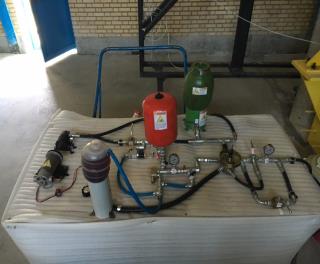
Rouhollah Ahmadi
Iran University of Science & Technology, Iran
Title: Clean desalination using reverse osmosis system providing pressure by energy harvesting from ocean waves
Biography
Biography: Rouhollah Ahmadi
Abstract
Statement of the Problem: The size of dirt particles contained in seawater varies widely. A very special filtration solution is required to remove particles from 10 mm at one end of the spectrum down to 50-micron particles at the other. Reverse osmosis (RO) water system is one of the promising methods that are employed in filtration of fine particles during desalination of seawater. However, this method requires huge energy to provide high pressure in the system. On the other hand, the growing of energy demand besides of the limitations of fossil fuels and hazardous impact of the environmental pollution caused by the consumption of fossil fuels makes renewable energies as attractive energy recourses. In this study, a desalination system using RO technique is introduced that its pressure is provided by energy harvesting from ocean waves. One of the sources of renewable energy, besides each desalination system, is sea waves. This paper aims to design and analyze the RO system connected to the sea waves energy harvester system. This system can be useful for the remote islands where they have a problem to access to potable water and common energy resources. To design a system for extracting energy from sea waves CFD model of special floating geometry was investigated. This floater can harvest of buoyancy energy as well as the inertial energy of wave impact. The behavior of floater is simulated by passing sea waves to find out the amount of energy harvesting. A hydraulic system connected to the floater to convert reciprocating motion to pressure in the accumulator. This pressure can be transfer to the RO system for refining filtration of sea water.
Image


Fig. 1 Ro system and energy harvester from sea wave
Publications
1. R. Ahmadi, S. M. Pourfatemi, S. Ghaffari, Exergoeconomic optimization of hybrid system of GT, SOFC and MED implementing genetic algorithm, Desalination Volume 411, 1 June 2017, Pages 76–88
2. R. Ahmadi, T. Okawa, Influence of surface wettability on bubble behavior and void evolution in subcooled flow boiling, International Journal of Thermal Sciences 97, pp. 114-125, 2015
3. R. Ahmadi, T. Okawa, Recognition of Net Vapor Generation in Subcooled Flow Boiling, I Journal of Multidisciplinary Engineering Science and Technology (ISSN: 3159-0040), Vol. 2, Issue 3, pp. 465-469 (2015)
4. R. Ahmadi, T. Ueno, T. Okawa, Visualization study on the mechanisms of net vapor generation in water subcooled flow boiling under moderate pressure conditions International Journal of Heat and Mass Transfer, Vol. 70, pp. 137-151 (2014).
5. R. Ahmadi, T. Ueno, T. Okawa, Experimental identification of the phenomenon triggering the net vapor generation in upward subcooled flow boiling of water at low pressure, International Journal of Heat and Mass Transfer, Vol. 55, No. 21-22, pp. 6067-6076 (2012).

